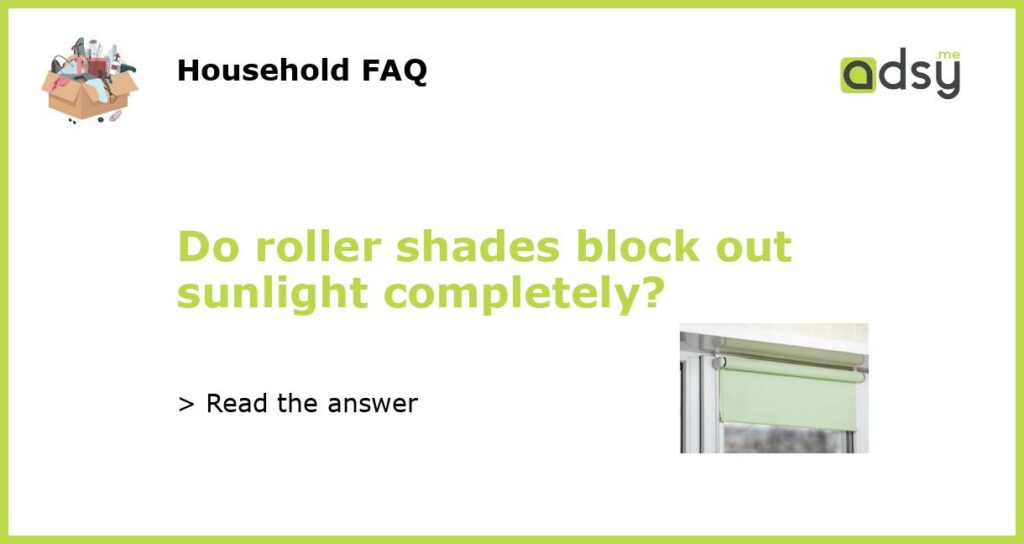Roller Shades: Do they Block Out Sunlight Completely?
Roller shades are a popular choice for window coverings due to their simplicity and versatility. Besides providing privacy, they also help control the amount of light and heat that enters a room. However, many people wonder if roller shades are capable of completely blocking out sunlight. In this article, we will explore the effectiveness of roller shades in blocking sunlight and discuss factors that may affect their performance.
Understanding Roller Shades
Roller shades are window coverings made of fabric or vinyl that can be rolled up or down to control light and privacy. They are typically operated manually or with the use of a chain or motorized mechanism. Roller shades come in various opacities, ranging from sheer to blackout, allowing homeowners to choose the level of light filtration and privacy they desire. While sheer roller shades diffuse light and provide a softer glow, blackout roller shades are specifically designed to block out sunlight completely.
Effectiveness of Blackout Roller Shades
Blackout roller shades are made with thicker, opaque fabrics that prevent any light from passing through. When properly installed, they can effectively block out sunlight and create a dark environment ideal for bedrooms, media rooms, or spaces where light control is crucial. The fabric used in blackout roller shades is often coated with a layer of vinyl or other light-blocking material to enhance its light-blocking capabilities.
It is important to note that while blackout roller shades can significantly reduce the amount of sunlight entering a room, they may not be able to completely eliminate all light. Some light may still seep in around the edges of the shades or through small gaps caused by imperfect installation or imperfectly fit windows. However, when properly installed and adjusted, blackout roller shades can create a near-blackout effect, minimizing the amount of sunlight that enters a room.
Factors Affecting Performance
The performance of roller shades in blocking out sunlight may vary depending on several factors:
- Installation: Proper installation is key to ensuring maximum light-blocking capabilities. It is essential to mount the shades close to the window frame and seal any gaps or spaces where light can enter.
- Fabric Type: The type of fabric used in roller shades will affect its light-blocking capabilities. Fabrics that have a higher opacity or are specifically designed for blackout purposes will provide better light control than sheer or lighter fabrics.
- Fit: Roller shades should be measured and customized to fit the exact size of the window to minimize light leakage. Well-fitted shades provide better light control and prevent unwanted sunlight from entering a room.
- Exterior Conditions: External factors such as the intensity of sunlight, time of day, and the presence of reflective surfaces outside the window can also affect the amount of sunlight that enters a room even with blackout roller shades. In some cases, external light may still be visible through the shade.
- Accessories: The addition of valances or side channels can further enhance the light-blocking capabilities of roller shades by reducing the amount of light leakage around the edges.
Alternatives to Consider
If complete sunlight blockage is a top priority, there are alternative window coverings that may provide better results than roller shades:
- Blackout Curtains: Blackout curtains are made with dense, light-blocking fabrics and typically have a liner attached at the back to enhance their light-blocking capabilities. They are available in a wide range of styles, patterns, and colors to suit different preferences.
- Cellular Shades: Cellular shades, also known as honeycomb shades, feature a unique design that traps air within their cells, providing insulation and light control. They are available in various opacity levels, including blackout options for maximum light-blocking capabilities.
- Shutters: Interior shutters are another option to consider. They are typically made of wood or composite materials and have adjustable louvers that can be tilted to control light and privacy. When fully closed, shutters can significantly block out sunlight.
While roller shades can effectively block out sunlight, their performance may vary depending on various factors. If complete sunlight blockage is essential, considering alternative window coverings such as blackout curtains, cellular shades, or shutters may provide more reliable results. Ultimately, the choice of window covering depends on individual preferences, budget, and desired level of light control.






